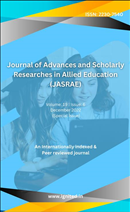Dyeing Cotton, Wool, and Silk with Allium Cepa
Keywords:
Dyeing Cotton, Wool, Silk and Allium CepaAbstract
Through the use of a dip-dry-iron-cure procedure, cotton fabric was treated with maleic anhydride, Allium cepa, and Terminalia arjuna all at once, with sodium citrate serving as an catalyst for esterification and free radical polymerization using potassium peroxodisulfate. Dyeing silk and cotton fabric with itaconic acid and maleic anhydride, or both, under the combined Catalysts for esterification and free radical polymerization caused chain polymer cross-linking to a certain extent, according to infrared analysis of the dyed fabrics. The purpose of this thesis is to increase the performance and versatility of dyed substrates by improving the balance of their qualities via the use of natural dyes applied to silk and cotton textiles.
Downloads
References
Agarwal, Jyoti & Sonia, (2021). Dyes and dyeing processes for natural textiles and their key sustainability issues. 10.1016/B978-0-12-821483-1.00013-9.
Fröse, Anastasia & Schmidtke, Karolina & Sukmann, Tobias & Juhász Junger, Irén & Ehrmann, Andrea. (2018). Application of natural dyes on diverse textile materials. Optik - International Journal for Light and Electron Optics. 181. 215-219. 10.1016/j.ijleo.2018.12.099.
Ansari, Saliha & Shaikh, Fiza & Patel, Khulud & Shaikh, Farida & Dodiya, Dharmi & Yadav, Ankit & Charania, Sheeza & Sawant, Surabhi & Kelkar, Veena. (2022). Extraction of natural dye from different flowers for dyeing cotton fabrics. 9. 102-107.
Fried, Richard & Oprea, Ilinca & Fleck, Karin & Rudroff, Florian. (2021). Biogenic colourants in the textile industry – a promising and sustainable alternative to synthetic dyes. Green Chemistry. 24. 10.1039/D1GC02968A.
Pandit, Pintu & Singha, Kunal & Maity, Subhankar. (2022). Introduction to Advancement in Textile Dyes and Pigments. 10.1002/9781119905332.ch1.
Said, Benkhaya & Harfi, Sara & Elharfi, Ahmed. (2017). Classifications, properties and applications of textile dyes: A review.
Singh, Kamaljit & Arora, Sucharita. (2011). Removal of Synthetic Textile Dyes From Wastewaters: A Critical Review on Present Treatment Technologies. Critical Reviews in Environmental Science and Technology. 41. 807-878. 10.1080/10643380903218376.
Sudarshan, Shanmugam & Harikrishnan, Sekar & Govindarajan, Rathi & Karthik, Alamelu & Aanand, S. & Rajasekar, Aruliah & Muthusamy, Govarthanan. (2022). Impact of textile dyes on human health and bioremediation of textile industry effluent using microorganisms: current status and future prospects. Journal of applied microbiology. 134. 10.1093/jambio/lxac064.
Mukherjee A, Nandi N, Mukherjee A (2011), ‘Discharge printing with natural dyes’, Text Trends, 45, 33-35.
Savvidis G, Karanikas E, Nikolaidid N, Eleftheriadis I, Tsatsaroni E (2014), ‘Ink-jet printing of cotton with natural dyes’, Color Technol, 130, 200-204.
Chattopadhyay SN, Pan NC, Roy AK, Saxena S, Khan A (2013), ‘Development of natural dyed jute fabric with improved colour yield and UV protection characteristics’, J Text Inst, 104, 808-818.
Savvidis G, Zarkogainni M, Karanikas E, Lazaridis N, Nikolaidid N, Tsatsaroni E (2013), ‘Digital and conventional printing and dyeing with the natural dye annatto: optimisation and standardisation processes to meet future demands’, Color Technol, 127, 55-63.
Kanchana, R. & Fernandes, A. & Bhat, B. & Budkule, S. & Dessai, S. & Mohan, R. (2013). Dyeing of textiles with natural dyes - An eco-friendly approach. International Journal of ChemTech Research. 5. 2102-2109.
Gupta, Virendra. (2019). Fundamentals of Natural Dyes and Its Application on Textile Substrates. 10.5772/intechopen.89964.











